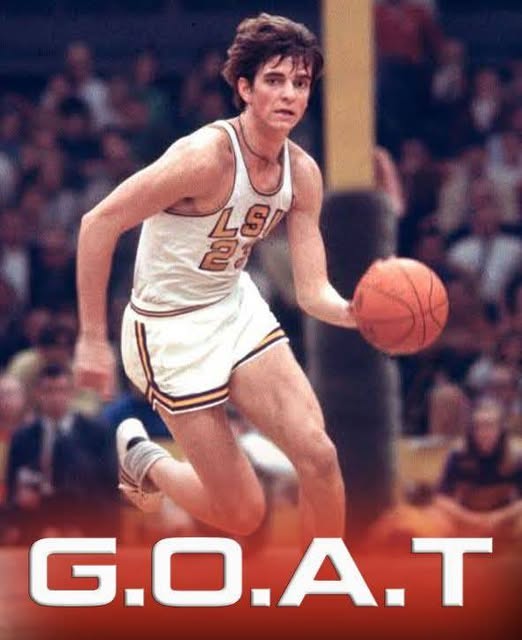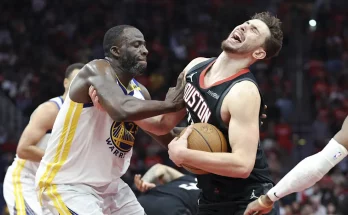In a monumental declaration that has sent waves through the college basketball world, ESPN has named LSU Tigers legend Pete Maravich as the Greatest of All Time (GOAT) in men’s college basketball. After an exhaustive evaluation that included statistical dominance, cultural impact, and enduring legacy, Maravich edged out elite company: Austin Carr of Notre Dame, Christian Laettner of Duke, Dan Issel of Kentucky, and Jerry Lucas of Ohio State.
This GOAT status, long championed by basketball purists and LSU faithful, finally receives its due recognition from one of the most influential sports networks. More than five decades after his final college game in 1970, Maravich’s legend has only grown more mythical—and now, indisputably cemented.
The Case for Pete Maravich
Known affectionately as “Pistol Pete,” Maravich played just three varsity seasons for the LSU Tigers from 1968 to 1970, due to NCAA rules at the time barring freshmen from playing on the varsity squad. Despite this, he amassed a jaw-dropping 3,667 points in only 83 games, averaging an all-time NCAA record 44.2 points per game—a record that still stands to this day.
What’s even more mind-blowing is that Maravich did it without a three-point line or shot clock. If those modern advantages had existed during his time, analysts estimate his scoring average could have hovered near 55 points per game, possibly eclipsing the 5,000-point mark.
His play was a mesmerizing mix of scoring artistry and jaw-dropping passes. Maravich wasn’t just a scorer—he was a performer. A magician with the ball. With floppy socks and mop-like hair, Pete captivated packed arenas and opposing fan bases alike. He brought NBA-level flair to a college game still rooted in fundamentals and set plays.
A Look at the Competition
Maravich’s victory in this ESPN GOAT debate was no small feat. The other candidates were legends in their own right:
Austin Carr (Notre Dame)
Carr averaged 34.6 points per game during his Notre Dame career and once scored 61 points in an NCAA Tournament game, a record that still stands. He was a pioneer of efficient scoring and left an indelible mark on March Madness lore.
Christian Laettner (Duke)
No player has had more NCAA Tournament success than Laettner. He appeared in four Final Fours and won two national championships, hitting the most iconic shot in tournament history—the game-winner against Kentucky in 1992. He is the only player ever to start in four consecutive Final Fours.
Dan Issel (Kentucky)
Issel was a scoring and rebounding monster, racking up 2,138 points and 1,078 rebounds during his Kentucky tenure. He was a bruising post player who left his mark on one of the sport’s most storied programs.
Jerry Lucas (Ohio State)
Lucas led the Buckeyes to a national championship in 1960 and was a three-time consensus All-American. His IQ, rebounding, and consistent excellence defined his era.
Despite the greatness of this group, Maravich stood apart for one simple reason—his game transcended time.
A Genius Before His Time
Maravich’s flair, creativity, and unlimited range predated the modern “space-and-pace” style of basketball. His no-look passes and behind-the-back dribbles would look right at home in today’s NBA. What makes him even more remarkable is how self-taught he was. Trained obsessively by his father and LSU coach Press Maravich, Pete practiced drills that were seen as unorthodox, even foolish, at the time—bouncing basketballs off walls, dribbling blindfolded, and shooting from impossible angles.
Yet it worked. Pete’s basketball IQ was years ahead of his peers. He saw passing lanes before they developed. He scored with ease from 30 feet out—at a time when that was considered wasteful. He was Steph Curry before Steph Curry, but with the flair of Magic Johnson and the improvisation of Allen Iverson.
A Polarizing But Beloved Figure
Not everyone was a fan of Maravich’s style during his playing days. Many critics felt he was too flashy or that he prioritized showmanship over team success. LSU never made an NCAA Tournament appearance during his tenure, which detractors used to downplay his greatness.
But as time has passed, those critiques have faded, replaced by a recognition that Maravich was a singular artist, trapped in an era that couldn’t fully appreciate him. He played on average teams and often faced defenses designed specifically to stop him—and he still scored at will.
His jersey, No. 23, is retired at LSU, and his name is etched into the very walls of Pete Maravich Assembly Center, the arena named in his honor. He was inducted into the Naismith Memorial Basketball Hall of Fame in 1987, just one year before his sudden death from a rare heart condition at the age of 40.
Enduring Legacy in College Hoops
What separates Maravich is the way he redefined what was possible in college basketball. Every generation of player that came after him owes a debt to his creativity and courage. His influence is felt every time a point guard throws a no-look dime or a player pulls up from deep with confidence.
Even players like Magic Johnson, Jason Williams, Steve Nash, and Kyrie Irving have cited Pistol Pete as an influence. And for modern fans, the countless YouTube highlight reels keep his memory alive—videos that still generate millions of views and fresh amazement.
ESPN’s GOAT Panel and Criteria
The ESPN panel for the GOAT debate consisted of historians, analysts, former players, and coaches. Their criteria extended beyond simple statistics. They included:
- Statistical Dominance
- Era Domination
- Influence on the Game
- Legacy and Recognition
- Intangibles and Iconic Moments
Maravich scored high across the board—his scoring average is the highest ever, he changed how guards played the game, and he remains one of the most beloved cult figures in basketball history. He didn’t need championships to be remembered. His impact was emotional, artistic, and transformative.
What This Means for LSU Basketball
LSU has had no shortage of great players, from Shaquille O’Neal to Ben Simmons, Chris Jackson (Mahmoud Abdul-Rauf) to Glen “Big Baby” Davis. But none of them can match the magic and lore of Pete Maravich.
This GOAT designation reignites LSU’s proud basketball legacy and shines a spotlight on one of the greatest talents the sport has ever seen. It’s also a point of pride for the SEC, which often gets overshadowed in basketball by ACC and Big Ten legends.
In an era where blue blood programs dominate headlines, Maravich’s coronation is a reminder that brilliance can emerge from anywhere—and that the game’s greatest ambassador might have played in Baton Rouge in the late ’60s.
Maravich and the Cultural Shift
Maravich was also a symbol of changing times. In the late 1960s, America was undergoing cultural upheaval, and sports were no exception. Maravich, with his floppy socks and rebel attitude, was anti-establishment in a sport that still clung to tradition.
He inspired a generation of kids to play with flair, to embrace their individuality, and to see basketball as expression, not just execution. In many ways, he was basketball’s first artist—a man whose canvas was 94 feet long, and whose brush was a Spalding basketball.
Final Thoughts: The Timelessness of Pistol Pete
As the GOAT debate rages across sports, Maravich’s selection by ESPN brings a welcome clarity to college basketball. While others may have more rings or more tournament moments, no one left an imprint on the soul of college basketball like Pistol Pete.
He was lightning in a bottle. The kind of player you tell your kids about. The kind who seems like folklore—but he was real. And now, he’s officially the Greatest of All Time.
And perhaps the most beautiful part? Pete Maravich never played for fame. He once said, “I don’t want to play 10 years in the NBA and die of a heart attack at age 40.” Tragically, he did exactly that. But in just three college seasons, he gave the game a heartbeat that still echoes 55 years later.


